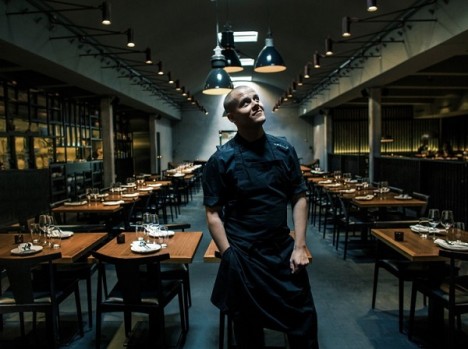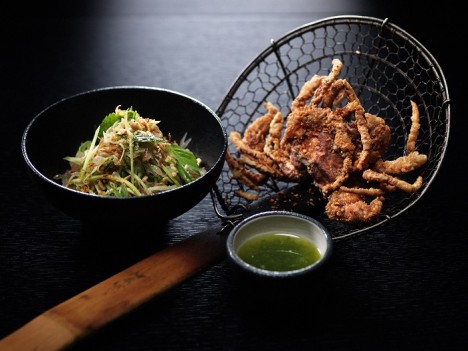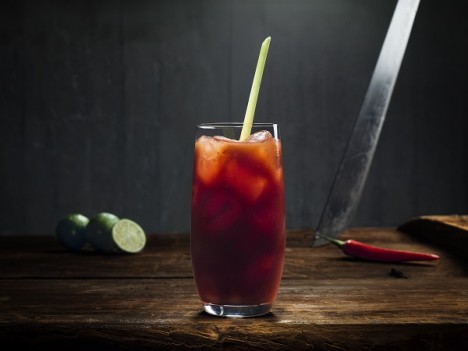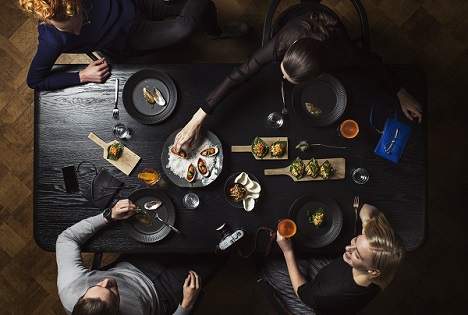The restaurant is central but slightly off the beaten track, just a couple blocks up from the chaotic shoppers on Drottninggatan in downtown Stockholm. A passer-by or lost tourist would never guess that the glass-and-brick building on the corner, complete with concrete entrance harking to the ‘70s, is in fact a culinary oasis.
Even once you step inside, you may not realize you’ve entered one of the best restaurants in town. The bar is simple, subdued; the cool, raw concrete walls greet guests like a mafia gangster – elegant, yet rough around the edges.
That’s the owners’ intent, of course.
“A lot of restaurants overdo the whole ethnic thing in the décor,” says Chef Kim Öhman.
“We wanted to keep it what it is; mixing the mystique of Asia – that polished style – with the rougher industrial side.”
But just a few more steps in and you’ll gasp as the room opens up, leading guests into a grand hall with high, vaulted ceilings, lit by warm candlelight all around – even though it's midday outside.
The fragrances of lemon grass and ginger delicately mingle and meander through the air, accompanied by the muted but merry laughter of guests sharing their meals.
“It’s really a social gathering, like eating with friends at home,” Öhman continues. “The food is designed to be shared – like tapas – and it’s fun.”

Photo: Marica Rosengård
Kim is one of three Finnish chefs conquering Scandinavian with their unique take on Thai cuisine.
Tomi Björck and Matti Wikberg opened the first Farang in 2009 in Finland – and it quickly won over Helsinki hearts.
“It was a fairy tale from the start. We won ‘Best restaurant in Finland’ several years in a row.”
And last year Kim Öhman took the concept to Stockholm.
“Thailand is one of the biggest tourist destinations for both Finns and Swedes, and everyone has a reference point to the food – good or bad,” Kim explains. “But most people have never eaten real Thai food, as opposed to the premade curries from fast food kiosks.”
The name, Farang, sounds exotic, reflecting the Asian spice so clearly in the menu. But the Finnish trio has a sense of humour.
“It means 'white guy',” Kim grins. “It's what the Thai call tourists.”
And indeed, the three chefs have done their best to make authentic Thai flavours more accessible for said “white guy” – the Scandinavian palate, accustomed to bland potatoes and basic brown sauce.
“There’s not much Southeast Asian food available in Europe. People here are quite scared of spices,” Kim says. “We take the spice and flavours of Thai food – the acidity from lime juice, the sweetness of palm sugar, the spicy chili – and we balance them for a European palate.”

Photo: Tuukka Koski
But the food is no less incredible for being more balanced.
The recipes are all classic Thai, and Kim says they make sure to use only the best ingredients – even when they’re hard to get.
“We’re not making fusion food; it’s just milder. We want to do it the right way, from start to finish, without any MSG or other additives,” he says.
“We use the best lemon grass, and Asian delicacies like banana blossoms, green mango, and green papaya.”
Farang even makes its own house curry – a labour intensive process which is quite rare in Europe, where premade spice blends rage rampant.
The team of chefs has even developed a perfectly tailored selection of wine to accompany the unique flavours of the food – and an enviable cocktail menu which lures patrons back time after time.
“Our Bloody Mary is the best in town,” Kim boasts, “And of course we do a proper Singapore Sling. And then we have a lot of our own signature drinks. There’s quite a pulse here in the evening.”

Photo: Tuukka Koski
But what is it about a Thai restaurant, hidden behind an industrial façade, which captivates tourists in the Swedish capital – instead of classic meatballs?
“It’s something different,” Kim says. “If you’re here on a seven-day holiday, you’ll get quite tired of Swedish pickles, potatoes, and mayonnaise – and all the French and Italian restaurants.”
Thai food is summer food, he adds – and at Farang, the food speaks for itself.
“It’s an explosion of flavours. You’ve just got to try it.”
This article was produced by The Local and sponsored by Farang.



 Please whitelist us to continue reading.
Please whitelist us to continue reading.